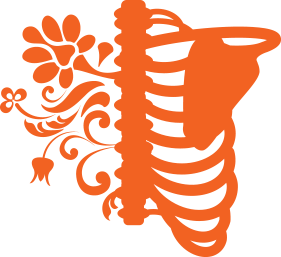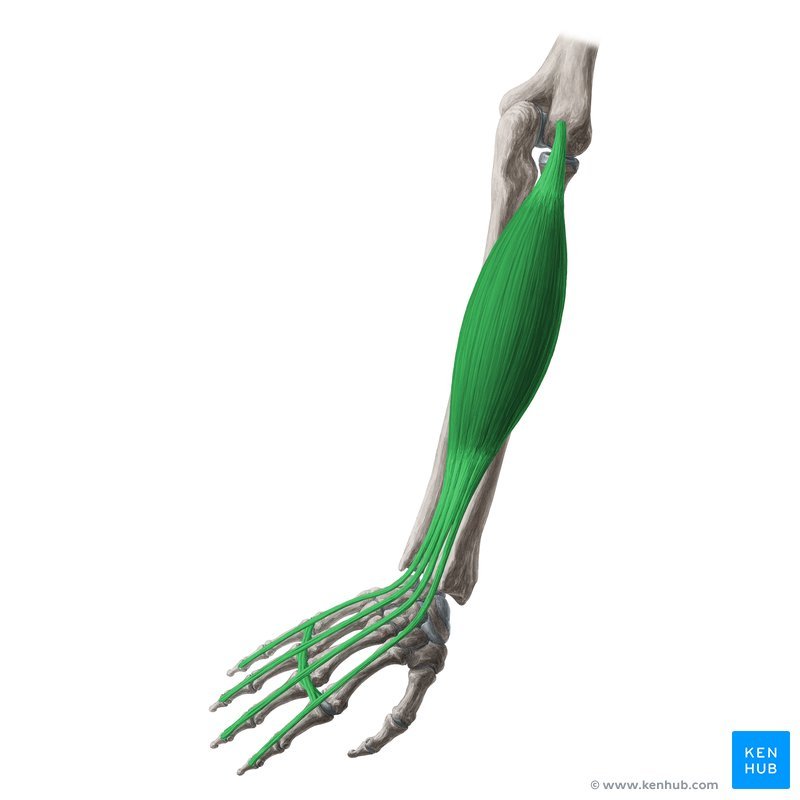Finger Pain Self Assessment
Pain is one of the ways in which our body communicates with our brain that something could be amiss. Acute episodes that resolve themselves quickly may not be worth investigating, but anything that is lingering or “nagging” is cause for concern.
“I have this nagging pain and stiffness in my middle finger knuckle” is a common complaint we hear from climbers seeking treatment. Often these clients have already tried several pain management protocols that have worked previously for common climber finger injuries, such as pulley tears. Maybe you have also tried taping, massaging, stretching, icing, heating and/or loading, but have not yet found lasting relief.
So what should you do when localized treatment directly to the painful, stiff finger doesn’t work? It may be time to “look up the chain” to see if something else might be contributing to your pain. Here we share our knowledge of the extensor digitorum muscle, its referral pattern, and how to self assess whether your finger pain is related to this muscle. If it is, the following could help you finally find relief from your nagging finger knuckle pain.
First, what is the Extensor Digitorum?
The extensor digitorum is one of the main muscles in the extensor compartment of your forearm. It attaches proximally to the outside of the elbow (lateral epicondyle), which is the thumb side of your elbow when your palm is facing forward.
While its tendons run down and attach to each finger, the muscle belly only exists in the forearm. Its main functions are to extend all four fingers, extend the wrist and also act on the wrist as the antagonist to your flexors. For climbers, you are using this muscle while:
Hanging/Climbing
During all grip actions
When performing weight bearing exercises on your fists
Weightlifting
Belaying, etc.
So what does the Extensor Digitorum have to do with finger knuckle pain?
Every muscle in our body has a referral pain pattern. A referral pattern occurs when the pain is felt in a different location in the body than where the problem originates.
One metaphor is to think of the chain reaction of dominoes. The last one to fall was acted upon by an initial force far away from it. Investigating the root cause, such as a trigger point in the muscle belly, can potentially relieve the pain in the referred location.
In this case, the extensor digitorum often refers directly to the index, middle and ring fingers–particularly at the first knuckle/PIP joint. So treating the muscle belly in the forearm may help relieve your finger pain.
How can you investigate and attempt to resolve your nagging finger pain?
Begin by palpating the muscles in the extensor compartment. Use your opposite hand and gently move along the “meaty muscle” along the outside of your forearm. Is it painful, tender or sore compared to the other side? Do you feel any knots, bands or nodules? If so, check out the following recommendations for manual release techniques to combine with exercises that might address the root of the problem.
Manual Release
While self-palpation can be helpful, we have found a device called the Armaid that is even more efficient. We recommend using this device on the extensor compartment to try and release the suspected tension upstream in the extensor digitorum.
The Tennis Elbow video located on Armaid's website is a great example of how and why to use this awesome device. They recommend to start slowly by using it for 2-3 minutes, 1-3 times per day. Massaging and pressing on tissue for too long can cause inflammation and hinder more than help; so ease into it.
If your finger pain is indeed connected to a problem in the extensor digitorum muscle, then your finger should feel better following this manual release treatment.
We have been personally using this device and prescribing it for our clients for over a decade. We are happy to share a discount code for your use on their website. Just enter GrassrootsArmaid at checkout for 10% off your purchase.
Recommended Exercises
If you have determined that the extensor digitorum is likely the source of your finger pain, try the following exercises to release the tension and, hopefully, relieve the pain.
You’ll notice that the first exercise is isotonic and the second is isometric, which mean “same speed” and “same length” respectively. When addressing the source of a problem, “iso” exercises have an analgesic effect and help to reduce pain. They also help to remodel damaged muscle and tendon tissue through progressive mechanical loading.
If performing any of these exercises worsens your pain during or after, then immediately stop and seek out an evaluation from a licensed therapist.
Exercise 1 – Isotonic Pronation and Supination
Isolate the rotation feature of your forearm and maintain a stable shoulder and elbow while you rotate slowly from fully supinated (palm up) to fully pronated (palm down). Begin with a light weight (like the PVC shown) to assess your range of motion. You can make it harder by holding lower on the pipe or broom stick, thereby increasing the lever that your forearm muscles have to work against. You can also use a free weight such as a hammer or adjustable dumbbell.
Perform 5-8 repetitions, rest 1-2 minutes and repeat 1-3 sets, 1-3 times per week. This move will help to free up and strengthen your Supinator and Pronator Teres muscles which could contribute to congestion and weakness at the forearm.
Exercise 2 – Isometric Wrist Extension
This exercise helps to restore range of motion at your wrist by strengthening the extensor muscle group, particularly the extensor digitorum muscle.
Align your arm from shoulder to wrist and choose a weight that you can hold steady for 30 seconds, rest 1-2 minutes, repeat 1-3 sets, 1-3 times per week.
You should feel fatigue and strain at the end of the 30 seconds, but not total failure or any pain.
Exercise 3 – Banded Spiderman
Practice pushing and extending your elbow and wrist through resistance. See if you can keep your elbow crease rotated toward the ceiling while maintaining pronation, wrist and finger extension all at the same time. It may be harder than it looks!
Begin with your palm down and create a bird beak position with your fingers. Then press into the resistance band with your entire arm and spread your fingers wide, pushing your wrist and fingers into full extension away from your body. Use your opposite hand to hold the band and control the tension.
Perform 5-8 repetitions, rest 1-2 minutes and repeat 1-3 sets, 1-3 times per week. Pay close attention to your affected finger and make sure it is able to fully straighten under the resistance. There should be no pain, only effort fatigue.
Exercise 4 – Rice Bucket
Watch the following video to learn the various exercises we suggest doing with a rice bucket. You can vary the difficulty by changing the grain you use. Wheat berries are easier, while rice provides more resistance.
More Resources to Explore
If you are having general wrist pain or rehabbing a finger pulley strain, then we recommend our Healthy Hand & Wrist Self Treatment video for a deeper dive into massage techniques with the Armaid, as well as complimentary stretches and mobilization exercises.
If you are already feeling symptomatic at the extensor digitorum itself, then you may benefit from our Tennis Elbow Self Treatment Video.
If you love to learn, then check out our YouTube channel for even more self treatment educational content. While it is particularly helpful for climbers, it is equally beneficial to guitar players and desk jockeys alike.
If you’re a climber who was taught to “hang on your bones” when resting on the wall, then we recommend reading our How to Hang Right Series to unlearn this myth.
We love hearing from people all over the world. So we welcome you to leave us a comment or reach out through email for follow up questions. We’re here to help!









